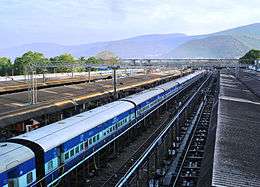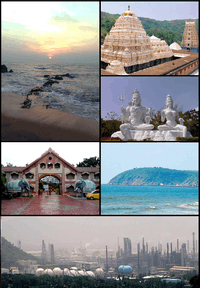Visakhapatnam
| Visakhapatnam విశాఖపట్నం Vizag - Waltair | |
|---|---|
| Metropolis | |
|
Top to bottom, left to right: A view of Visakhapatnam and the Bay of Bengal from Kailasagiri Park, Simhachalam Temple, King George Hospital, Visakhapatnam Port, the Kursura Submarine Museum, the Visakhapatnam Steel Plant, and Ramakrishna Mission Beach | |
|
Nickname(s): The City of Destiny, The Jewel of the East Coast Goa of the East Financial Capital of Andhra Pradesh | |
 Visakhapatnam  Visakhapatnam | |
| Coordinates: 17°41′18″N 83°13′07″E / 17.68833°N 83.21861°ECoordinates: 17°41′18″N 83°13′07″E / 17.68833°N 83.21861°E | |
| Country | India |
| State | Andhra Pradesh |
| District | Visakhapatnam |
| Named for | Viśakha |
| Government | |
| • Body | Greater Visakhapatnam Municipal Corporation (GVMC) |
| • Municipal commissioner | M.Hari Narayanan |
| • Commissioner of Police | T.Yoganand,I.P.S. |
| • Superintendent of police | Rahul Dev Sharma |
| • District collector | Praveen Kumar, I.A.S |
| Area[1] | |
| • Metropolis | 540.00 km2 (208.50 sq mi) |
| • Metro[2] | 5,573 km2 (2,152 sq mi) |
| Elevation[3] | 45 m (148 ft) |
| Population (2011) | |
| • Metropolis | 2,035,922 |
| • Rank |
14th (India) 1st (Andhra Pradesh) |
| • Density | 3,800/km2 (9,800/sq mi) |
| • Metro[2] | 5,340,000 |
| Demonym(s) | Vizagite |
| Languages | |
| • Official | Telugu |
| Time zone | IST (UTC+5:30) |
| PIN | 530 0XX, 531 1XX |
| Telephone code | +91-891-XXX XXXX |
| Vehicle registration | AP–31,32,33,34 |
| Website | Greater Visakhapatnam Municipal Corporation |
Visakhapatnam (nicknamed Vizag) is the largest city, both in terms of area and population in the Indian state of Andhra Pradesh. It is located on the coast of Bay of Bengal in the north eastern region of the state. It is the administrative headquarters of Visakhapatnam district and also the Financial Capital of Andhra Pradesh.[4] As of 2011, the population of the city was recorded as 2,035,922, making it the 14th largest city in the country.[1] The Visakhapatnam Metropolitan Region is the 9th most populous in India with a population of 5,340,000[5]
Visakhapatnam's economy ranks as the eighth-largest among Indian cities, with a GDP of $48 Billion (USD).[6][7] Visakhapatnam is the principal commercial hub of the state, and contributes to its economy in many sectors such as heavy industries, tourism, industrial minerals, fishing, and information technology. Visakhapatnam Port is the fifth busiest port in India in terms of cargo handled.[8] Visakhapatnam is home to the oldest shipyard and the only natural harbour on the east coast of India.[9][10]
Visakhapatnam's history stretches back to the 6th century BCE. Historically, it was considered part of the Kalinga ancient region,[11][12] and later ruled by the Vengi kingdom, the Pallava and Eastern Ganga dynasties.[13] Archaeological records suggest that the present city was built around the 11th and 12th centuries CE with control over the city fluctuating between the Chola Dynasty and the Gajapati Kingdom[11][12] until its conquest by the Vijayanagara Empire in the 15th century.[13] Conquered by the Mughals in the 16th century, European powers eventually set up trading interests in the city, and by the end of the 18th century it had come under French rule.[11][12] Control passed to the British in 1804 and it remained under British colonial rule until India's independence in 1947. After independence, Visakhapatnam developed into one of the country's chief ports and became the headquarters of the Eastern Naval Command of the Indian Navy.[11][12]
The city is nestled between the Eastern Ghats mountain range and the Bay of Bengal, and is often known as The Jewel of the East Coast, The City of Destiny and the Goa of the East Coast.[9] Visakhapatnam's beaches (such as Ramakrishna Mission Beach and Rushikonda), parks (such as Kailasagiri and VUDA Park), museums (such as the Kursura Submarine Museum and Visakha Museum), and proximity to areas of natural beauty (such as the Kambalakonda Wildlife Sanctuary, Araku Valley, and Borra Caves) have helped the city become a significant tourist destination.[14][15]
Visakhapatnam has been selected as one of the hundred Indian cities to be developed as a smart city under PM Narendra Modi's flagship Smart Cities Mission. Visakhapatnam was ranked as the fifth cleanest city in India according to the government's Swachhta Sarvekshan rankings.[16]
Etymology
The name Visakhapatnam was derived from the shrine of God Visakha, built by a King of Andhra in 4th century.[17]
Geography


It is situated between the Eastern Ghats to its west and the Bay of Bengal to its east, bordering on the north with the state of Orissa and Vizianagaram district and East Godavari District to the south. The city coordinates lies between 17.6883° N latitude, and 83.2186° E longitude. It's periphery consists of plains along the coast line while the interiors boast of the beautiful hills of the Eastern Ghats which surround it on the North and the West. This region is also called the Agency Division. It occupies an area of approximately 11,161 km2 (4,309 sq mi).
History
Visakhapatnam's history stretches back to the 6th century B.C.E., and the city finds mention in ancient texts, such as the 4th century B.C.E. writings of Pāṇini and Katyayana. Historically considered part of the Kalinga region,[11][12] it was ruled by the Vengi kingdom and the Pallava and Eastern Ganga dynasties during medieval times.[13] Archaeological records suggest that the present city was built around the 11th and 12th centuries C.E. by the Chola Dynasty king Kulothunga I. Control over the city fluctuated between the Chola Dynasty of Tamil Nadu and the Gajapati Kingdom of Odisha[11][12] until its conquest by the Vijayanagara Empire in the 15th century.[13] In the 16th century, it was conquered by the Mughals. European powers eventually set up trading interests in the city, and Visakhapatnam came under French rule at the end of the 18th century.[11][12]
The city was ruled by Andhra Kings of Vengi and Pallavas. The city is named after Sri Vishaka Varma, Legend has it that Radha and Viśakha were born on the same day, and were equally beautiful. Sri Vishaka Sakhi, is the second most important gopi of the eight main gopis. She carries messages between Radha and Krishna, and is the most expert gopi messenger. Local residents believe that an Andhra king, built a temple to pay homage to his family deity Viśakha. This is now inundated under sea water near R K Beach. Another theory is that it is named after a women disciple of Buddha named Viśakha. Later it was ruled by Qutb Shahis, Mughal Empire (between 1689 and 1724), Nizam (1724–1757) and France (1757–1765) before being captured by the British in 1765. European powers eventually set up trading interests in the city, and Visakhapatnam came under French rule at the end of the 18th century.[11][12]
The British captured Visakhapatnam after the 1804 Battle of Vizagapatam, and it remained under British colonial rule until India's independence in 1947 which was a part of the Northern Circars.
Buddhist influence
Hindu texts state that during the fifth century BC, the Visakhapatnam region was part of Kalinga territory, which extended to the Godavari River. Relics found in the area also prove the existence of a Buddhist empire in the region. Kalinga later lost the territory to King Ashoka in the bloodiest battle of its time, which prompted Ashoka to embrace Buddhism. Visakhapatnam is surrounded by ancient Buddhist sites, most of which have been excavated recently and illustrate the legacy of Buddhism in the region.
Pavurallakonda

Pavurallakonda ("pigeon hill") is a hillock west of Bhimli, about 24 km (15 mi) from Visakhapatnam. The Buddhist settlement found here is estimated to date back from the first century BC to the second century AD. On the hillock (which overlooks the coastline) are 16 rock-cut cisterns for collecting rainwater. Gopalapatnam, on the Tandava River, is a village surrounded by brick stupas, viharas, pottery and other Buddhist artefacts.[18]
Sankaram

In 1907 British archaeologist Alexander Rea unearthed Sankaram, a 2,000-year-old Buddhist site. The name "Śankaram" derives from the Sangharama (temple or monastery). Located 40 km (25 mi) south of Visakhapatnam, it is known locally as Bojjannakonda and is a significant Buddhist site in Andhra Pradesh. The three major schools of Buddhism (Hinayana, Mahayana and Vajrayana) flourished here. The complex is known for its monolithic stupas, rock-cut caves and brick structures. The primary stupa was initially carved out of rock and covered with bricks. Excavations yielded historic pottery and Satavahana coins from the first century AD. At Lingalakonda, there are also rock-cut monolithic stupas in rows spread over the hill. The vihara was active for about 1,000 years.
Nearby is another Buddhist site, Bojjannakonda, with a number of images of the Buddha carved on the rock face of the caves. At Ligalametta there are hundreds of rock-cut monolithic stupas in rows, spread across the hill. Among other Buddhist attractions are a relic casket, three chaitya halls, votive platforms, stupas and Vajrayana sculptures.
Bavikonda
Bavikonda is an important Buddhist heritage site located on a hill about 15 km, northeast from Visakhapatnam city. Here the Buddhist habitation is noticed on a 16 ha flat terraced area. The Hinayana school of Buddhism was practised at the monastery between the 3rd century B.C. and the 3rd century A.D. Bavikonda has remains of an entire Buddhist complex, comprising 26 structures belonging to three phases. A piece of bone stored in an urn recovered here is believed to belong to the mortal remains of the Budda. The word Bavikonda in Telugu means "a hill of wells". Fitting its name, Bavikonda is a hill with wells for the collection of rainwater. It is located 15 km (9.3 mi) from Visakhapatnam and is a significant Buddhist site. Excavation carried out from 1982 to 1987 revealed a Buddhist establishment including a mahachaitya embedded with relic caskets, a large vihara complex, numerous votive stupas, a stone-pillared congregation and rectangular halls and a refectory. Artifacts recovered from the site include Roman and Satavahana coins and pottery dating from the third century BC to the second century AD. A significant finding was a piece of bone (with a large quantity of ash) in an urn, which is believed to be the remains of the Buddha. The Bavikonda site is considered one of the oldest Buddhist sites in Asia. It is a reminder of the Buddhist civilisation which once existed in southern India, and also reminiscent of Borobudur in Indonesia.[19]
Thotlakonda

About 16 km (9.9 mi) from Visakhapatnam is Thotlakonda, a Buddhist complex situated on top of a hill. The Buddhist Complex on the Mangamaripeta hilltop, locally known as Totlakonda, lies about 16 km from Visakhapatnam on Visakhapatnam-Bheemili Beach Road. After its discovery (during an aerial survey), the Government of A.P. declared the 48 ha site as a protected monument in 1978. Excavations in 1988 to 1992 exposed structural remains and artefacts, classified as Religious, Secular and Civil. These structures include the Stupa, Chaityagrihas, pillared congregation halls, bhandagaras, refectory (bhojanasala), drainage and stone pathways. The site covers an area of 120 acres (49 hectares), and has been declared a protected area by the government of Andhra Pradesh. Excavations have revealed three kinds of structural remains: religious, secular and civil. Structures include a mahastupa, sixteen votive stupas, a stone-pillared congregation hall, eleven rock-cut cisterns, well-paved stone pathways, an apsidal chaitya-griha, three round chaitgya-grihas, two votive platforms, ten viharas and a kitchen complex with three halls and a refectory (dining hall). Apart from the structures, Buddhist treasures excavated include nine Satavahana and five Roman silver coins, terracotta tiles, stucco decorative pieces, sculptured panels, miniature stupa models in stone, Buddha padas depicted with ashtamangala symbols (i.e. the eight auspicious symbols of Swastika, Shrivasta, Nandhyavarta, Vardhamanaka, Bhadrasana, Kalasha, Minyugala and Darpan) and early pottery.[20]
Later history

The territory of Visakhapatnam then came under the Andhra rulers of Vengi, and Chalukyas and Pallavas ruled the land. The region was ruled by the Eastern Ganga king- SuryaVamsa Kshatriyas and the Gajapati kings of Odisha from the 10th century to the 16th centuries AD (when the region came under the Visakhapatnam rulers). Based on archaeological evidence, the Prabhakar and the Eastern Ganga Kings of Odisha built temples in the city in the 11th and 12th centuries. The Mughals ruled the area under the Visakhapatnam Nizam during the late 15th and early 16th centuries. European merchants from France, Holland and the East India Company used the natural port to export tobacco, paddy, coal, iron ore, ivory, muslin and other textile products.
Local legend tells that an Andhra king, on his way to Benares, rested at Visakhapatnam and was so enchanted by its beauty that he ordered a temple to be built in honour of his family deity, Viśakha. Archaeological sources, however, reveal that the temple was probably built between the 11th and 12th centuries by the Cholas. A shipping merchant, Shankarayya Chetty, built one of the mandapams (pillared halls) of the temple. Although it no longer exists (possibly washed away about 100 years ago by a cyclonic storm), elderly residents of Visakhapatnam remember visits to the ancient shrine by their grandparents (although author Ganapatiraju Atchuta Rama Raju denies this).[21]
During the 18th century Visakhapatnam was part of the Northern Circars, a region comprising coastal Andhra and southern coastal Odisha which was first under French control and later British. Visakhapatnam became a district in the Madras Presidency of British India. In September 1804, British and French squadrons fought the naval Battle of Vizagapatam near the harbour. After India's independence it was the largest district in the country, and was subsequently divided into the districts of Srikakulam, Vizianagaram and Visakhapatnam.
Part of the city is known by its colonial British name, Waltair; during the colonial era, the city's hub was the Waltair railway station and the surrounding part of the city is still called Waltair.
- International Fleet Review 2016
Climate
| Climate data for Visakhapatnam | |||||||||||||
|---|---|---|---|---|---|---|---|---|---|---|---|---|---|
| Month | Jan | Feb | Mar | Apr | May | Jun | Jul | Aug | Sep | Oct | Nov | Dec | Year |
| Record high °C (°F) | 34.8 (94.6) |
38.2 (100.8) |
40.0 (104) |
40.5 (104.9) |
45.0 (113) |
45.4 (113.7) |
41.4 (106.5) |
38.8 (101.8) |
38.2 (100.8) |
37.2 (99) |
35.0 (95) |
34.0 (93.2) |
45.4 (113.7) |
| Average high °C (°F) | 28.9 (84) |
31.3 (88.3) |
33.8 (92.8) |
35.3 (95.5) |
36.2 (97.2) |
35.3 (95.5) |
32.9 (91.2) |
32.7 (90.9) |
32.5 (90.5) |
31.7 (89.1) |
30.4 (86.7) |
28.9 (84) |
32.5 (90.5) |
| Average low °C (°F) | 18.0 (64.4) |
19.9 (67.8) |
23.0 (73.4) |
26.1 (79) |
27.7 (81.9) |
27.3 (81.1) |
26.1 (79) |
26.0 (78.8) |
25.6 (78.1) |
24.3 (75.7) |
21.6 (70.9) |
18.6 (65.5) |
23.7 (74.7) |
| Record low °C (°F) | 10.5 (50.9) |
12.8 (55) |
14.4 (57.9) |
18.3 (64.9) |
20.0 (68) |
21.1 (70) |
21.3 (70.3) |
21.1 (70) |
17.5 (63.5) |
17.6 (63.7) |
12.9 (55.2) |
11.3 (52.3) |
10.5 (50.9) |
| Average precipitation mm (inches) | 11.1 (0.437) |
10.5 (0.413) |
13.0 (0.512) |
26.2 (1.031) |
70.5 (2.776) |
117.0 (4.606) |
133.3 (5.248) |
163.6 (6.441) |
191.1 (7.524) |
258.1 (10.161) |
115.5 (4.547) |
8.8 (0.346) |
1,118.7 (44.042) |
| Average rainy days | 0.5 | 0.5 | 0.5 | 1.2 | 3.0 | 6.4 | 8.7 | 9.3 | 9.9 | 8.7 | 2.7 | 0.6 | 52.0 |
| Average relative humidity (%) | 71 | 70 | 69 | 71 | 69 | 71 | 76 | 77 | 78 | 74 | 68 | 67 | 71.8 |
| Source #1: India Meteorological Department (record high and low up to 2010)[22][23] | |||||||||||||
| Source #2: NOAA (humidity 1971–1990)[24] | |||||||||||||
Demographics
Visakhapatnam is a cosmopolitan mix of people from various parts of India. From a population of a few thousand during the 18th and early 19th centuries, the population grew steadily. The city doubled its population from 1990 to 2000, due to a large migrant population from surrounding areas and other parts of the country.
| Historical population | ||
|---|---|---|
| Year | Pop. | ±% |
| 1871 | 32,191 | — |
| 1881 | 30,291 | −5.9% |
| 1891 | 34,487 | +13.9% |
| 1901 | 40,892 | +18.6% |
| 1911 | 43,413 | +6.2% |
| 1921 | 44,711 | +3.0% |
| 1931 | 57,303 | +28.2% |
| 1941 | 70,243 | +22.6% |
| 1951 | 108,042 | +53.8% |
| 1961 | 211,190 | +95.5% |
| 1971 | 363,467 | +72.1% |
| 1981 | 603,630 | +66.1% |
| 1991 | 752,037 | +24.6% |
| 2001 | 1,345,938 | +79.0% |
| 2011 | 2,035,922 | +51.3% |
As of 2011 Census of India, Visakhapatnam had a population of 1,728,128. The total population constituted 873,599 males, 854,529 females, – with a sex ratio of the city being 978 females per 1000 males. There were a total of 1,279,137 literates, of which 6,88,678 were male and 5,90,459 were females literates. The average literacy rate of the citywas 81.79%. in Visakhapatnam city as of 2011. There were 164,129 in the age group of 0–6 years, with 84,298 boys and 79,831 girls. The child sex ratio was 947 girls per 1000 boys.[1][25] Visakhapatnam is ranked 122 in the list of fastest-growing cities in the world.[26][27] The population was increased after the expansion of the city limits and stands at 2,035,922.[28]
Hinduism is practised by the majority of its citizens, followed by Islam and Christianity. The area practised Buddhism for two millennia, as evidenced by the many Buddhist sangharamas in the outlying areas; currently, however, the population of Buddhists has waned, with approximately 3‱ Buddhist population in the entire Greater Visakhapatnam Municipal Corporation as of 2011.[29] There is little religious tension.
Language
Telugu is the official language of Visakhapatnam.[30] Two dialects of Telugu are spoken by the people, the common dialect and the Uttarandhra (North Eastern Andhra) dialect. The latter is mainly spoken by the people who originally belong to the districts of Vizianagaram and Srikakulam.[30] A cosmopilitan population of Visakhapatnam comprise Tamils,[31][32] Malayalis,[33][34] Sindhis[35] and Kannadigas,[36][37] and also Bengalis and Odia migrants from other regions of India.[38][39] People from other states are also present due to the presence of Naval base and high concentration of public-sector employers. There is also an Anglo-Indian community.
Governance
Greater Visakhapatnam Municipal Corporation (or GVMC) is the civic body of the city. It has a jurisdictional area of 540 km2 (210 sq mi), which includes the merged municipalities of Gajuwaka, Anakapalle and Bheemunipatnam.[1][40] While, Visakhapatnam Metropolitan Region extends to 5,573 km2 (2,152 sq mi) with a population of 53,40,000 and is under the administration of Visakhapatnam Urban Development Authority.[2] The present municipal commissioner of the city is M.Hari Narayanan.[41]
Economy

Visakhapatnam has developed into a major economic destination. It has all the sectors like Industrial, Fishing, IT, Pharma, Export & Imports by Sea trade etc. The city was identified as one of the fastest-growing in the world, economically and demographically.[42][43] Several factors contributed to its economic growth, including the natural harbour, rail, road and air connectivity to national and International destinations. Tourism also plays an important role in generating revenue to the state of Andhra Pradesh, with many tourist spots in and around the city, attracts large number of tourists.[44]
Ports
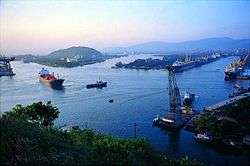
Fishing is a major sector in the city and has one of the largest harbour in the country for the fishing industry and seafood exports. A number of fishermen have their livelihoods depending on fishing in the city. The ice factories in and outside the Fishing Harbour, caters to the needs of the fishermen and provides employment as well.[45]
Visakhapatnam Port and Gangavaram Port are helping to develop the petroleum, steel, and fertilizer industries. The city is a hub for iron ore and other mineral exports which are exported by sea to other countries. Fishing Harbour at Visakhapatnam Port Trust is one of the biggest in the Coastal corridor of Andhra Pradesh generating huge revenue.[46][47]
Industrial sector
There are many Special economic zones and industrial corridors such as, VSEZ, APSEZ, APIIC, Aganampudi Industrial Park, Visakha Dairy, JNPC, Brandix Apparel City etc., are located in and around the city. Andhra Pradesh Industrial Infrastructure Corporation (APIIC) is a special economic zone (covering 5,770 acres (23.4 km2). It is occupied by industries such as WS Industries, Pokarna Limited, Uniparts, Confidence Petroleum, Southern Online Bio, Nagarjuna AgriChem, Anjaney Alloys, Maithon Alloys and Abhijit Ferro Alloys. Asian Paints to set up Rs. 1750-cr greenfield plant near Vizag.[48] Brandix Apparel City is a textile-based SEZ covering 1,000 acres (4.0 km2). The aim of this project is to provide 60,000 local jobs.[49] The SEZ has textile manufacturers namely Pioneer Elastic Fiber, Ocean India, Quantum Clothing, Fountain Set Group and Limited Brands. Pilkington, an automotive-glass manufacturer is also has its company. Jawaharlal Nehru Pharma City (JNPC) is the only pharmaceutical SEZ in India, with 58 pharmaceutical companies including PharmaZell of Germany and Eisai Pharma of Japan.[50]
Heavy industries
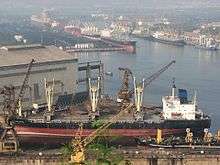
The defence controlled Hindustan Shipyard built India's first ship Jala Usha. Ports and Shipyard led to many private sectors to set up large-scale industries. Some of them include, Visakhapatnam Export, GAIL, HPCL, BHEL, Hindustan Zinc, Dredging Corporation of India, Coromandel Fertilizers, RINL and LG Polymers, Jindal Stainless Steels, Synergies Castings, Rain Calcining Limited, Reliance, Brandix, Essar Pellet Plant, Andhra (Cements, Petrochemicals and Ferroalloys) Ltd. etc.
Visakhapatnam has a steel plant, whose corporate entity RINL is the second largest state-run steel industry. The capacity of the plant is 6.3MT, is planned to become a 20MT plant in the future, the largest plant in a single location. The plant had revenues of ₹144,570 million (US$2 billion) for 2011–2012 and has about 17,800 employees.
IT/ITES industry

Visakhapatnam is experiencing growth in the IT sector, contributing to the local economy.[51]
Incubation centre in Visakhapatnam is named as Sunrise Startup Village, the Technology Research and Innovation Park, promoted by the Government of Andhra Pradesh and Startup Village in Private Public Partnership basis at Hill 3 Rushikonda IT Park in Visakhapatnam on the line of Startup Village kochi. .[52] Among all the startups Unihalt is the first financially sustainable startup mentored by SV.[53] An area of 21.16 acres on Hill No. 3 in Rushikonda has been allocated and is identified for construction of the iconic Signature Tower.[54]
The government has established an IT special economic zone and incubation centre in the Rushikonda Hills. Its skilled workforce allowed the entry of many national and international IT and banking firms such as Tech Mahindra, Wipro, IBM Kanexa, Infotech, Concentrix, WNS and HSBC.
Prestigious R&D project of Society for Applied Microwave Electronics Engineering and Research (SAMEER) is coming up in Gambheeram in Visakhapatnam. Government of India announced its decision to invest Rs.80 crore on India's first Centre for Electromagnetic Environmental Effects (E3) in Vizag under aegis of SAMEER. This will be the fourth SAMEER lab after it set up microwave, electromagnetic and millimetre wave research facilities respectively in Mumbai, Chennai and Kolkata. [55] IT turnover from Vizag has remained at around Rs.1500 crore with a growth rate of 15 to 20 per cent. There is a proposal to develop a cluster exclusively for small and medium entrepreneurs by allotting 100 acres.
Three of the Global Big Four, Google Inc., Accenture and IBM, and India's IT giants TCS and Infosys are to open offices in the city.[56]
Resources
Minerals
The prevalence of ferroalloy plants is due to the availability of manganese ore near Visakhapatnam. Aluminium refineries such as Anrak Aluminium and Jindal Aluminium are developing because of the bauxite reserves around the city.[57] India's first rare earths (minerals) extraction plant at Atchutapuram is owned by Toyotsu Rare Earth India Ltd. (Partners of Toyota).
Petroleum, chemicals and petrochemicals

Visakhapatnam was one of five sites in the country selected to hold strategic crude-oil reserves in case of a national emergency. IOC and BPCL have their bottling units in the city. Hindustan Petroleum expanded and the Visakhapatnam Export Processing Zone was established. Visakhapatnam is a part of the Petroleum, Chemical and Petrochemical Investment Region (PCPIR), proposed between Visakhapatnam and Kakinada. The PCPIR is expected to generate 1.2 million jobs and a projected investment of ₨34,30,000 million.[58]
Power Plants

Simhadri Super Thermal Power Plant of NTPC Limited is expanding from 1,000 to 2,000 MW at a cost of ₹50 billion (US$743 million). Hindujas has begun construction of a 1,070-MW thermal power plant in Visakhapatnam district at a cost of ₹70 billion (US$1 billion).[59]
NTPC is establishing 4x1,000 MW imported coal-based thermal power plant in Visakhapatnam district in Andhra Pradesh, which will come up at an investment of Rs 20,000 crore. Approximately Rs 5 crore outlay is needed for generation of one megawatt thermal power.[60] [61]
Cityscape
Neighbourhoods
Over the years, Visakhapatnam has turned from a fishing village into a commercial city with busy streets. Most notable areas of the city include Dwaraka Nagar, Gajuwaka, Gopalapatnam, Jagadamba Centre, Maddilapalem, Madhurawada, Seethammadhara etc.

Landmarks
.jpg)
Visakhapatnam is one of the main tourism destinations in the state of Andhra Pradesh. The city is famous for beaches, caves and the Eastern Ghats as well as wildlife sanctuaries.[62]
The landmarks of the city include Dolphin's Nose, Lighthouse, Kailasagiri, Beach Road, VUDA Park, Visakha Museum and Matsyadarsini (an aquarium). INS Kursura Submarine Museum is the only of its kind in India.[44] Indira Gandhi Zoological Park in the city has variety of wildlife species. Erra Matti Dibbalu (Red sand dunes) are situated between Visakhapatnam and Bheemunipatnam are one of the geo-heritage sites in the country. This tourist spot is now protected and preserved as a heritage site.[63] Dr Ramanaidu Film Studio in 33 acres space off the Visakha-Bhimili beach road is one of the film shootings destination.[64] Telugu Heritage museum on atop Kailasagiri amid picturesque surroundings is developed by World Telugu Federation and Visakhapatnam Urban Development Authority ,[65] Vuda City Central Park .[66] Adding one more feather to its cap visakhapatnam has got india's tallest musical fountain opened in the central park. Oscillating vertically at 360 degrees, the fountain dances to the tune of digital music in different colors.[67]
Beaches along the coastline of the Bay of Bengal are Ramakrishna Mission Beach, Rushikonda Beach and Mangamaripeta Beach. Others include Yarada, Bheemili, Lawson's Bay, Tenneti, Sagar Nagar and Gangavaram beaches.[68]
Araku Valley, 112 km (70 mi) from Visakhapatnam is a hill station at an elevation of over 1,000 metres (3,300 ft). Borra Caves are caves discovered by British geologist William King in 1807.[69] Tyda (an Eco tourism project), Kambalakonda Wildlife Sanctuary under Andhra Pradesh Forest Department are wildlife conservation sites near the city.[44] Kondakarla Ava, a natural lake and bird sanctuary, is 50 km south of Visakhapatanam. [70]
- RK Beach at Sunset
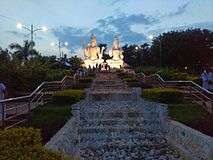 Lord Shiva and Parvathi on Kailasagiri
Lord Shiva and Parvathi on Kailasagiri Yarada Beach
Yarada Beach
Culture

Poets, artists Some of the notable poets from the city include Sri Sri, Gollapudi Maruti Rao, Sirivennela Seetharama Sastry.
Religious worships
Some of the religious sites are also of great importance like ISKCON temple;[71] Simhachalam temple of Lord Narasimha 16 km (9.9 mi) north of the city,[72][73] Sri Kanaka Maha Lakshmi Temple. Recent archaeological excavations of Buddhist shrines revealed Buddhist dominance in this area and these are recognised as heritage sites that include Boudharamam, Saligudam, Sankaram and Devipuram etc.
Transport
Roadways
Visakhapatnam is one of the major cities on the east coast of India connected by NH5, a major highway and a part of the Golden Quadrilateral system of Indian highways connecting Chennai and Kolkata. The city has a broad network of roads. The city has a total road length of 2007.10 km.[74] State owned APSRTC runs buses to various places of the state.
Residents of Visakhapatnam use city buses run by APSRTC, that runs buses along a number of routes across the city and its suburbs. The APSRTC complex at Asilametta is the hub for most of these buses. As of now the city has two Bus Rapid Transit System (BRTS) on Pendurti and Simhachalam corridors. Click here to view the bus route numbers of visakhapatnam
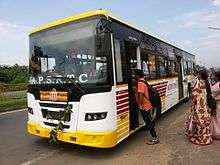 Visakhapatnam Metro Express Highway Service at Kurmanapalem
Visakhapatnam Metro Express Highway Service at Kurmanapalem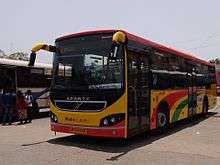 Vizag Metro in PNBS
Vizag Metro in PNBS
Railways
The city's railway station was originally called Waltair railway station. In around 1987, Mr. D. V. Subbarao, the then mayor of Visakhapatnam, changed the name to Visakhapatnam. Visakhapatnam railway station is administered by the East Coast Railway of Indian Railways and is the headquarters for the Waltair Railway Division. It will be de-linked from East Coast Railway once a new railway zone for Andhra Pradesh is formed and will be part of new zone according to AP Reorganisation act 2014.
It is located on the Chennai Central-Howrah Station route, although the main line bypasses the Central Station. Duvvada railway station, a suburban station on the main line (near the Visakhapatnam Steel Plant) is being developed into a satellite hub to improve train service into the city.
There are direct rail links to many parts both in and outside the state to all major junctions. Kothavalasa–Kirandul line from Visakhapatnam to Kirandul via Araku is laid through eastern ghats. Up to Araku station it is having 84 bridges and 58 tunnels.[75] Also, it pass through South India's highest elevation broad gauge station, Similiguda, just before Borra caves. Visakhapatnam also shelters the country's largest Diesel Loco Shed with a capacity of 206.[76]
Metro rail
A metro rail project has also been planned by the Greater Visakhapatnam Municipal Corporation to arrest chaotic traffic condition on the streets. After the proposal was submitted by the GVMC in February 2014, the Urban Transport Department gave in-principle approval for going ahead with feasibility studies and a detailed project report (DPR).[77]
DMRC has been given the task of surveying and preparing a project report for Visakhapatnam Metro Rail. DMRC submitted the plan to the Andhra Pradesh government on 27 August 2014.
The first phase of the Vizag Metro Rail (VMR) will be completed by December 2018 with financial support from the Japan International Cooperation Agency (JICA)[78]
Airport
Visakhapatnam Airport is the busiest airport in Andhra Pradesh. It is connected by daily flights with Dubai, Singapore, Kuala Lumpur, Chennai, Coimbatore, Delhi, Mumbai, Bangalore, Hyderabad, Kolkata, Kochi, Mangalore, Bhubaneshwar, Raipur, Tirupathi, Port Blair and Vijayawada. Visakhapatnam Airport has been operating night flights, and the airport is 24hr operational.[79]
Seaports
On the east coast of India, Visakhapatnam serves as the gateway waterway for Andhra Pradesh. It has one of the country's largest ports, and the oldest shipyard on the east coast. It is a land-locked harbour,[80] as connected to the sea by a channel cut through rock and sand. Visakhapatnam is one of the busiest ports in India. Vizag Seaport owns two berths in the inner harbour; berth EQ-8 is fully mechanised and berth EQ-9 berth is not. Both berths are capable of handling Panamax vessels. The shipyard at Visakhapatnam is the largest in India. On the Chennai–Kolkota corridor, the city is also a hub for ground traffic. The Gangavaram Port is India's deepest seaport. In December 2010, Coal India agreed to enable an additional berth to be built at the port.[81]
 Visakhapatnam seaport, with harbour interchange fly-by road
Visakhapatnam seaport, with harbour interchange fly-by road- Skyline, overlooking seaport
Pollution
While there are many industries and power plants in and around Visakhapatnam, the major cause of pollution due to coal dust is the Visakhapatnam Port Trust.[82] This is mainly due to handling of cargo like coal and iron ore without adequate facilities to prevent pollution. The public have represented many times to the Port authorities but still the problem exists and it is a major health concern today. Protests have taken place too without any effect in reducing the pollution[83]
Education
Visakhapatnam is considered as a centre for education in Andhra Pradesh and there are a number of primary, high schools and colleges in the city. In addition to state-run schools there are private institutions, missionary schools and colleges.
Primary education
St. Aloysius Anglo Indian High School was established in the year 1847.The one of the oldest school in city with 168 years history.[84] Timpany, Delhi, Bethany School are the others. There are Kendriya vidyalaya's which are situated in NAD, Steel plant, Industrial estate and Waltair which are affiliated to CBSE. City also has many schools which teaches State Syllabus, ICSE, CBSE.
Secondary education
Established in 1878, A.V.N. College is one of the city's oldest educational institutions.[85] Visakhapatnam is also home to Andhra University (AU), established in 1926. President of India, Sarvepalli Radhakrishnan was vice-chancellor of the university between 1931 and 1936. AU and its affiliated colleges provide education to thousands of students up to Postgraduation in many fields. The AU College of Pharmacy is the second-oldest pharmacy college in India. The university is in the process of obtaining IIEST status.
University
Andhra Medical College, established in 1902, is the home of several teaching hospitals. Andhra University College of Engineering (Autonomous), The GITAM University (the first private university in Andhra Pradesh) and the Gayatri Vidya Parishad College of Engineering are other technical-education institutions in the city.
Visakhapatnam is also home to Damodaram Sanjivayya National Law University, which is the National Law University for the state of Andhra Pradesh. DSNLU takes entrance through Common Law Admission Test and ranks 15th by order of establishment among the 17 National Law Universities. Vizag is due to get India's First Packaging park[86] with an Indian Institute of Packaging, IIP[87] and BITS Pilani & Birla International School under the aegis of Sarala Birla Academy.[88]
The Indian Maritime University was established as a central university by the government of India by an act of Parliament (the Indian Maritime University Act 2008). IMU is poised to play a role in the development of human resources for the maritime sector. Visakhapatnam also has the National Institute of Oceanography. The Indian Institute of Management,[89] Indian Institute of Petroleum and Energy[90] are the other institutions of national importance.
Defence and research
Naval base

Visakhapatnam is the headquarters of the Eastern Naval Command, the Naval Science and Technological Laboratory (a DRDO Lab), a Chief Quality Assurance Establishment (CQAE), an EFS office, a Naval Dockyard (established in 1949) and Naval Bases including INS Virbahu, INS Karna, INS Kalinga, INS Samudrika, INS Satavahana, and INS Dega. A new base at INS Rambilli is being built on 5,000 acres (20 km2) with an investment of ₹15 billion (US$223 million), as the first dedicated submarine base in India. India's first nuclear submarine INS Arihant was launched in the Naval Dockyard, and Bharat Dynamics has begun manufacturing torpedoes. Visakhapatnam also has presence of the Indian Coast Guard including ships and offices. Multiple naval training establishments, such as the Navy ShipWright School,[91] are also situated here.
Research organisations
The Bhabha Atomic Research Centre (BARC) plans its second research facility in the country (after Trombay) in the area.[92] A permanent facility, which will include a school dedicated to nuclear-power technology. There are also offices of the National Institute of Oceanography and the India Meteorological Department.
Sports
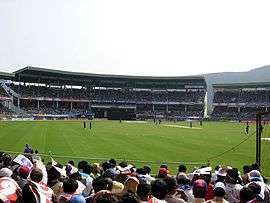
Cricket is the most popular sport, followed by tennis and football. Visakhapatnam is home to a number of local cricket teams participating in district and zone matches. Gully cricket (a form of cricket played in streets or parks) is a popular pastime for local youth. Visakhapatnam co-hosted the 32nd National Games alongside, Hyderabad in 2002. The city has seven cricket stadiums, which are used for Ranji Trophy matches; two of these stadiums have been used for one day international matches. Some of these stadiums are:
- Indira Priyadarshini Stadium: Also known as the Municipal Corporation Stadium, hosted the first ODI match on 9 December 1988 and the last of the five on 3 April 2001. The stadium has discontinued in favour of the new ACA-VDCA Stadium in Madhurawada.

- ACA-VDCA Stadium is the home of Andhra Cricket Association as well as to Visakhapatnam district. It hosts both Ranji Trophy and One Day Internationals. The stadium is the home ground of Andhra Pradesh cricket team. Sometimes, it also hosts IPL matches as a neutral venue. The stadium is named after the former chief minister, late Y.S. Rajasekhara Reddy. The ACA-VDCA Stadium was recently awarded test status making it the 9th venue in the country with test status. It hosted its first test match against England beginning on 17 November 2016.
- Port Trust Golden Jubilee Stadium: Second-largest stadium in Visakhapatnam, which has hosted Under-19 Youth Internationals. It also hosted the 2014 Pro Kabaddi League season as the home ground for the Telugu Titans.[93]
In addition to the cricket grounds, the Swarna Bharathi Indoor Stadium, built by the Greater Visakhapatnam Municipal Corporation, is used for various indoor sports,[94] and the GVMC Aqua Sports Complex, an aquatic centre for swimming and diving, is near the beach road.[95]
Media
The Telugu dailies publishers in the city are Eenadu, Andhra Jyothy, Sakshi, Andhra Bhoomi, Andhra Prabha, Vaartha, Suryaa and Prajasakti. Apart from the local language, there are also English papers such as, The Hindu, The Times of India, Deccan Chronicle, The Hindu Business Line, The New Indian Express and The Hans India. On 8 April 2016, the city was host for the Ganta China Rosaiah and Narayanamma Memorial Best Journalists Awards-2015.[96]
FM stations in Vizag
- Radio City - 91.1 - Telugu / Hindi
- Big 92.7 FM - 92.7 - Telugu / Hindi
- Red FM - 93.5 - Telugu
- Radio Mirchi - 95.0 - Hindi
- Radio Mirchi - 98.3 - Telugu
- AIR FM Rainbow - 102.0 - Telugu
- Gyan Vani - 105.6 - Telugu / English / Hindi
Notable people
- Sir C. V. Raman
- Srirangam Srinivasa Rao
- Tenneti Viswanadham
- Sarvepalli Radhakrishnan
- R. P. Patnaik
- Gollapudi Maruti Rao
- P. T. Srinivasa Iyengar
- Gurazada Apparao
- Kotcherlakota Rangadhama Rao
- Kambhampati Hari Babu
- Nookala Chinna Satyanarayana
- Sri Kantha Krishnamacharyulu
- Devika Rani
See also
References
- 1 2 3 4 "Municipalities, Municipal Corporations & UDAs" (PDF). Directorate of Town and Country Planning. Government of Andhra Pradesh. Archived from the original (PDF) on 7 June 2016. Retrieved 29 January 2016.
- 1 2 3 "Key Facts on VMR" (PDF). Visakhapatnam Urban Development Authority. pp. 44–45. Retrieved 21 December 2015.
- ↑ "Elevation for Visakhapatnam". Veloroutes. Retrieved 26 August 2015.
- ↑ "Administration-AP-Financial Capital". Visakhapatnam. 29 April 2015. Retrieved 13 August 2015.
- ↑ "Key Facts Of VMR www.vuda.gov.in" (PDF). Retrieved 17 February 2016.
- ↑ "India's top 15 cities with the highest GDP".
- ↑ Nicole Bippen (17 February 2014). "The 10 Richest Indian Cities". The Richest. Retrieved 15 July 2014.
- ↑ "Competition shakes up Visakhapatnam port". HT Mint. 11 February 2010. Retrieved 22 November 2012.
- 1 2 Students Academy (14 November 2014). Visakhapatnam-The City of Destiny-India. Lulu.com. p. 5. ISBN 978-1-257-06510-3. Retrieved 14 November 2014.
- ↑ Gopalakrishnan, Hema (7 November 2012). "A career in Vizag". The Hindu. Retrieved 18 May 2015.
- 1 2 3 4 5 6 7 8 "Maps of India – Visakhapatnam History". Maps of India. Retrieved 9 May 2015.
- 1 2 3 4 5 6 7 8 "History Of Visakhapatnam". I Love India. Retrieved 9 May 2015.
- 1 2 3 4 "Visakhapatnam District". Visakhapatnam District. Retrieved 9 May 2015.
- ↑ "Museums in Vizag". Retrieved 9 May 2015.
- ↑ "Kambalakonda Wildlife Sanctuary". Archived from the original on 23 September 2015. Retrieved 9 May 2015.
- ↑ Moushumi Das Gupta (15 February 2016). "Mysuru India's most 'Swachh' city again, Varanasi among the dirtiestMoushumi Das Gupta". Hindustan Times. New Delhi. Retrieved 15 February 2016.
- ↑ Satya Raju, Rapaka (1989). Urban Unorganised Sector in India. Mittal Publications. p. 69. Retrieved 26 August 2015.
- ↑ "Pavuralakonda". timesofindia. Retrieved 12 December 2012.
- ↑ "bavikonda". www.buddhist-tourism.com. Retrieved 7 September 2015.
- ↑ "thotlakonda". The Hindu. Retrieved 18 June 2015.
- ↑ "Viśakha traces its name to Buddhist princess". The Hindu. 15 July 2002. Retrieved 24 September 2009.
- ↑ "Visakhapatnam Climatological Table Period: 1951–1980". India Meteorological Department. Retrieved 25 March 2015.
- ↑ "Ever recorded Maximum and minimum temperatures up to 2010". India Meteorological Department. Archived from the original on 21 May 2013. Retrieved 25 March 2015.
- ↑ "Visakhapatnam Climate Normals 1971–1990". National Oceanic and Atmospheric Administration. Retrieved 25 March 2015.
- ↑ G, Siva (25 August 2014). "Greater Visakhapatnam Municipal Corporation polls unlikely this year". The Times of India. Retrieved 26 August 2015.
- ↑ Shekharjyoti Kalita. "Eleven Indian cities among 100 fastest growing cities in the world". Merinews.com. Retrieved 24 September 2009.
- ↑ "World's fastest growing urban areas (1)". City Mayors. Retrieved 6 May 2014.
- ↑ "District Census Handbook – Visakhapatnam" (PDF). Census of India. pp. 26–27, 52. Archived from the original (PDF) on 19 November 2015. Retrieved 21 December 2015.
- ↑ Visakhapatnam Religion Census 2011
- 1 2 "Visakhapatnam language". Maps of India. Retrieved 28 August 2015.
- ↑ staff reporter. "Celebration time for Tamilians". thehindu. Retrieved 13 April 2014.
- ↑ Rani Devalla. "Blend of tradition and creativity". www.thehindu.com. Retrieved 21 October 2015.
- ↑ Rani Devalla. "Malayalis feel at home in Vizag". www.thehindu.com. Retrieved 18 September 2013.
- ↑ {cite web|author= B.Madhugopal|url= http://www.thehindu.com/news/national/andhra-pradesh/malayalees-seek-direct-daily-train-to-mangalore/article7960594.ece |title=Malayalees seek direct daily train to Mangalore|publisher=www.thehindu.com |date= |accessdate=8 December 2015}
- ↑ Rani Devalla (10 November 2014). "Sindhis make merry". The Hindu. Retrieved 7 May 2016.
- ↑ Sulogna Mehta. "Kannadigas make a mark by displaying their rich tradition". timesofindia.indiatimes. Retrieved 31 March 2013.
- ↑ Rani Devalla. "Kannadigas in celebration mode". timesofindia.indiatimes. Retrieved 17 November 2014.
- ↑ Sulogna Mehta. "Cosmo Vizag celebrates Shivaratri". timesofindia.indiatimes. Retrieved 28 February 2014.
- ↑ "1500 cultural associations of Vizag". The Hindu. Retrieved 21 July 2012.
- ↑ "GOs issued on merger of two civic bodies, 10 panchayats". The Hindu. Visakhapatnam. 31 July 2013. Retrieved 15 February 2016.
- ↑ "Vizag on path to become ODF city". The Hindu. 30 September 2016. Retrieved 5 October 2016.
- ↑ David Satterthwaite (2007) The transition to a predominantly urban world and its underpinnings. Human Settlements Discussion Paper Series. Theme: Urban Change −4
- ↑ 11 Indian cities among world's fastest growing. Times of India. (23 October 2007). Retrieved on 3 December 2011.
- 1 2 3 "Vizag city tourism". AP Tourism Department. Retrieved 28 May 2014.
- ↑ "Employment Provided by Fishing Harbour". THE HINDU. Retrieved 10 April 2015.
- ↑ "Vizag port tops in seafood exports". THE HINDU. Retrieved 3 July 2015.
- ↑ "gangavaram-lng-terminal with 5-million-tonne project may see an investment of 4,500 crore". thehindubusinessline. Retrieved 28 April 2015.
- ↑ "ASAIN PAINTS". THE HINDU. Retrieved 10 March 2015.
- ↑ "Home". brandixapparelcity.com. Retrieved 23 October 2015.
- ↑ ":: Jawaharlal Nehru Pharmacity". Ramky.com. 21 February 2005. Retrieved 6 May 2014.
- ↑ "IT Industry in Vizag". The Hindu. Retrieved 8 May 2014.
- ↑ "Starup village in Vizag". The Hindu. Retrieved 30 September 2014.
- ↑ "Visakhapatnam's first startup gets going".
- ↑ "Signature Tower in Vizag". The Hindu. Retrieved 10 December 2014.
- ↑ "tech-mahindra-sameer-to-set-up-mega-projects-in-vizag". The Hindu. Retrieved 29 July 2014.
- ↑ "IT Giants setting up offices in Vizag". The Hindu. Retrieved 29 September 2014.
- ↑ "bauxite plants-in-vizag". timesofindia. Retrieved 18 January 2014.
- ↑ "Hpcl plans huge investment". The Hindu. Retrieved 23 January 2015.
- ↑ "NTPC-invites-tenders-for-4000-mw-power-plants-in-vizag". dnaindia. Retrieved 25 March 2015.
- ↑ "NTPC simhadri mulling expansion". The Hindu. Retrieved 19 April 2015.
- ↑ "hinduja plant-in-vizag". business-standard. Retrieved 3 November 2014.
- ↑ India. "Visakhapatnam, Andhra Pradesh India Tourist Information". Touristlink.com. Retrieved 6 May 2014.
- ↑ "Scenic Erra Matti Dibbalu Now Declared a Geo heritage Site". newindianexpress. Retrieved 24 July 2014.
- ↑ "Dr Ramanaidu Film Studio". www.indiaglitz.com. Retrieved 18 August 2008.
- ↑ "CM to open Telugu Heritage Museum". thehindu. Retrieved 19 November 2015.
- ↑ "Central Park to have 'iconic' fountain". thehindu. Retrieved 24 December 2015.
- ↑ http://www.thehansindia.com/posts/index/Andhra-Pradesh/2016-08-25/Vizag-to-have-Indias-tallest-musical-fountain/250478
- ↑ Gilai, Harish (27 July 2015). "Vizag Beaches Among Most Dangerous in World, Here's Why". The New Indian Express. Retrieved 15 February 2016.
- ↑ "Visakhapatnam-The City of Destiny-India". google.co.in.
- ↑ "kondakarla-ava". go2india. Retrieved 7 September 2015.
- ↑ "ISKCON temple". iskconvizag. Retrieved 28 May 2014.
- ↑ "Hisrtory of temple". simhachalam. Retrieved 28 May 2014.
- ↑ "About Simhachalam temple". simhachalam. Retrieved 28 May 2014.
- ↑ "DETAILS OF ROADS IN EACH ULB OF ANDHRA PRADESH".
- ↑ "Araku Valley | Places to See, Vizag". IN: Visitvizag.in. Retrieved 28 August 2015.
- ↑ "Diesel Locomotive Shed, Visakhapatnam" (PDF). Indian Railways. Retrieved 28 August 2015.
- ↑ "Vizag metro Tenders issued". Deccan-Journal. Retrieved 25 June 2014.
- ↑ "First phase of Vizag metro rail to be ready by end of 2018 – The Times of India". timesofindia.indiatimes.com. Retrieved 23 October 2015.
- ↑ "Visakhapatnam Airport". Airports Authority of India. Retrieved 20 May 2015.
- ↑ Santosh Patnaik Beach nourishment taken up on a bigger scale. Hindu.com (8 March 2010). Retrieved on 3 December 2011.
- ↑ "Coal India strikes port deal". fairplay.co.uk. 18 December 2010. Retrieved 18 December 2010.
- ↑ "Pollution envelops Vizag; port authorities face flak". The Hindu Business Line. 2010-04-27. Retrieved 2016-10-29.
- ↑ Bureau, Our (2015-04-10). "Vizag port draws flak for coal dust pollution". The Hindu Business Line. Retrieved 2016-10-29.
- ↑ "St. Aloysius Anglo Indian High School". www.aloysius.school. Retrieved 2 September 2015.
- ↑ "Home Page of Mrs. A.V.N. College". Avncollege.ac.in. Retrieved 6 May 2014.
- ↑ "News: India's first packaging park likely to be set up in Vizag – PrintWeek India". ProPrint.
- ↑ "IIP studying viability of extension centre in Visakhapatnam". The Times of India.
- ↑ "Four sites identified for BITS, Sarala Birla Academy in district". The Times of India.
- ↑ Sumit Bhattacharjee. "IIM-V to begin with flagship programme in management". The Hindu.
- ↑ "Petroleum Minister Launches Website of IIPE Visakhapatnam".
- ↑ "ShipWright School : Training : Indian Navy". indiannavy.nic.in.
- ↑ "BARC Second campus in Vizag". http://the Hindu. Retrieved 6 August 2009.
- ↑ "Pro Kabaddi League season". timesofindia. Retrieved 18 July 2014.
- ↑ "sports indore stadium". GVMC sports. Retrieved 3 September 2015.
- ↑ "GVMC Aqua Sports Complex". http://the Hindu. Retrieved 27 April 2012.
- ↑ "Entries sought from journalists". Visakhapatnam. 25 January 2016. Retrieved 7 February 2016.
Further reading
- "DMRC to prepare report on Vizag metro rail". 12 September 2014. Retrieved 19 September 2014.*
External links
| Wikimedia Commons has media related to Visakhapatnam. |
- Visakhapatnam at DMOZ
-
 Visakhapatnam travel guide from Wikivoyage
Visakhapatnam travel guide from Wikivoyage -
 Chisholm, Hugh, ed. (1911). "Vizagapatam". Encyclopædia Britannica (11th ed.). Cambridge University Press.
Chisholm, Hugh, ed. (1911). "Vizagapatam". Encyclopædia Britannica (11th ed.). Cambridge University Press.

